Alleys of Lijiang Ancient Town

Another full day in Lijiang broguht me the realization that I could spend weeks photographing here. Every twist and turn uncovered a mix of multiple cultures, their art, their lifestyles, languages, and their welcoming to this village. I could have snapped megapixels of everything I saw while I was there, everything that astounded me, but as the days went on, I learned to put the camera aside and just enjoy the unrecorded experience as it passed.
Either by planning, or by unfortunate circumstance, I found myself continuously emerged in interesting situations and by no means did I ever regret any turn, other than not staying longer.
I came to Lijiang to photograph the superb landscapes I saw in books and online.
One such landscape was the Black Dragon Pool, which is the quintessential scenic spot of the valley.
Easy… it’s within walking distance of my hotel and the park is maybe $15 to enter.. not bad. I can spend a morning there, obtaining a classic photo of my own instead of those stock ones that adorn postcards and calendars. Unfortunately, the global climate had other ideas. The Black Dragon Pool, like many other bodies of water in the mountain, had gone dry. So there I was, at the park entrance, trying to decide if the admission price would be worth it sans the reflective lake, and what other options I had for photographing in the morning. I ended up going back to see it in 2016.
Hey look… signs of Rochester. (other than a stack of film, they had no other Kodak-branded merchandise)

Back to the streets of the Old Town… to shop, eat, and be entertained by the sights. I processed this photo in black and white because I was curious if the streets of the old town was indiscernible from that era of photography. I do prefer the color.
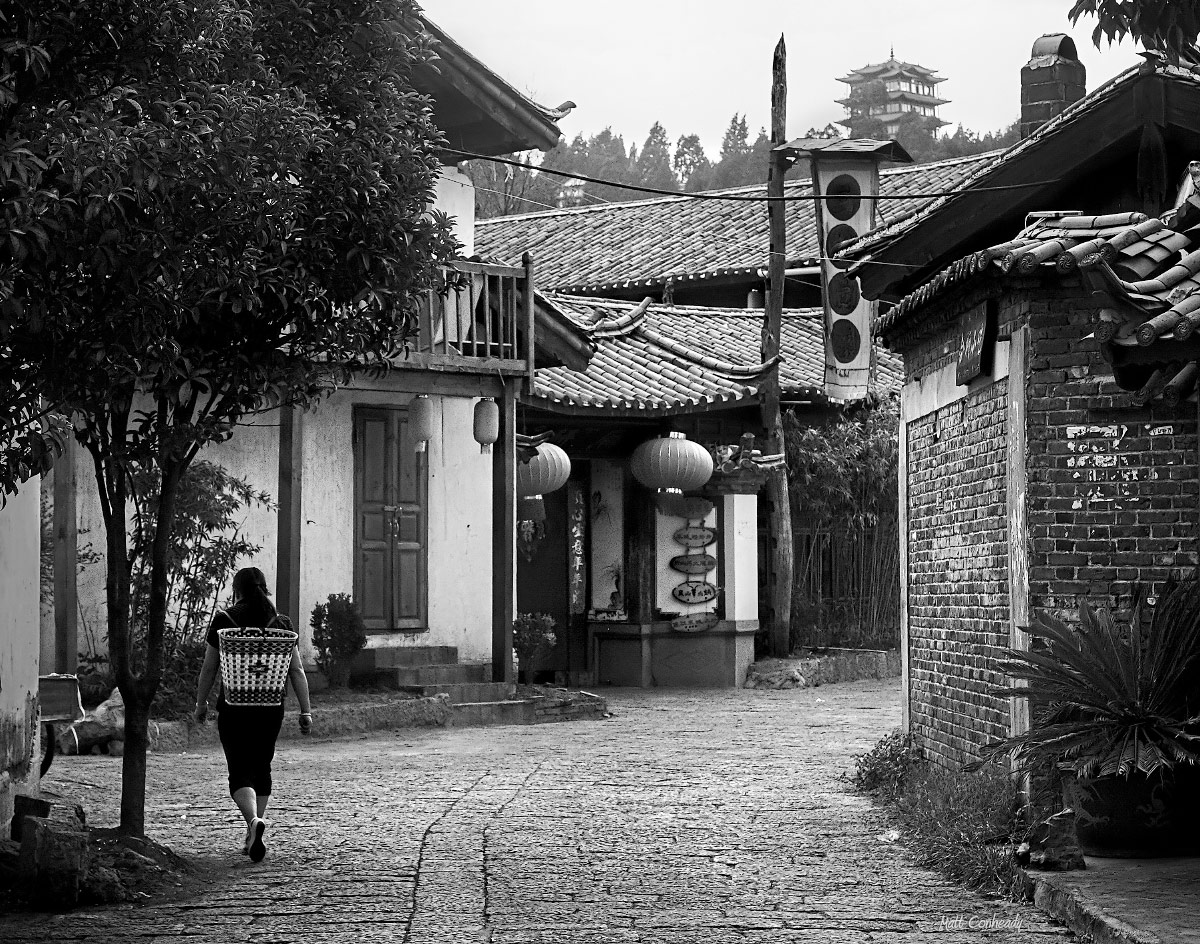
Hundreds of shops and restaurants, each with its own personality. are closely packed within the alleys. In traditional style, the entrances to an eatery is an art form.



This is a door leading to the town library, which encourages tourists take a look at all the tourism book and historic records.

Even down seemingly void alleys is at least one welcoming shop awaiting customers.
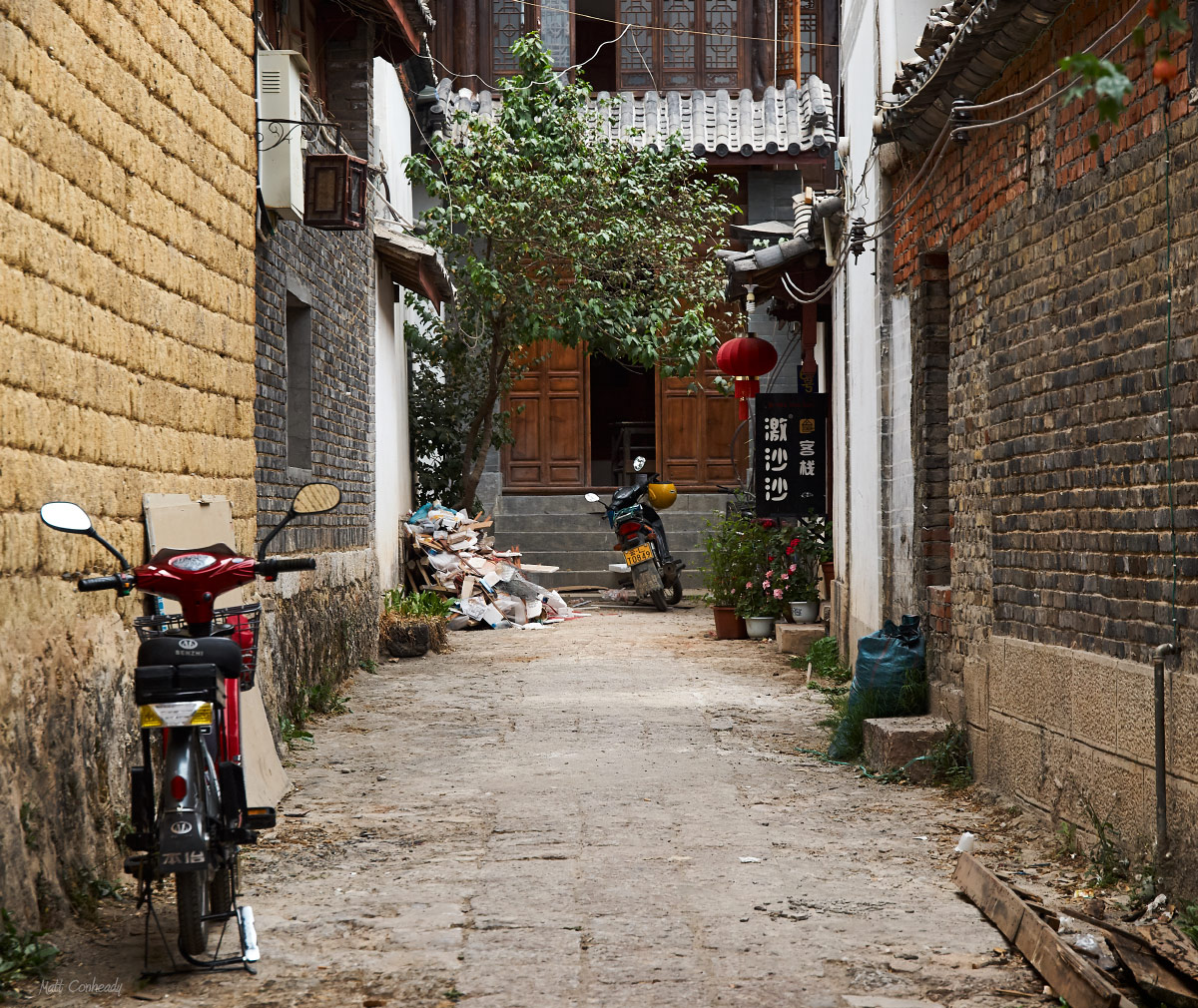



Of particular interest to me, the Dongba language, written in an ancient pictographic script. Many have taken to colorizing the script as an art form.
A large stone wall was adorned with a story written in colorized Dongba. It was pointless to get a clear photo of it without a girl or two modeling in front of it. Several shops in the area specialized in Dongba calligraphy on scrolls.

Lijiang’s rapid change from isolation from modern influence to “model tourism city of China” has mixed those used to the traditional lifestyle with those there for the commerce and nightlife. Nearly every street has a group of young men and women jamming loudly on these drums. When I asked the significance of this, i was told, “This is Lijiang. Where else can someone just go and use a drum all day?”

Shrimp on a stick (to be grilled to order). Seafood disgusts me. How does one eat the whole animal–from eyes to butthole?

Beetle larvae on a stick (to be grilled to order).
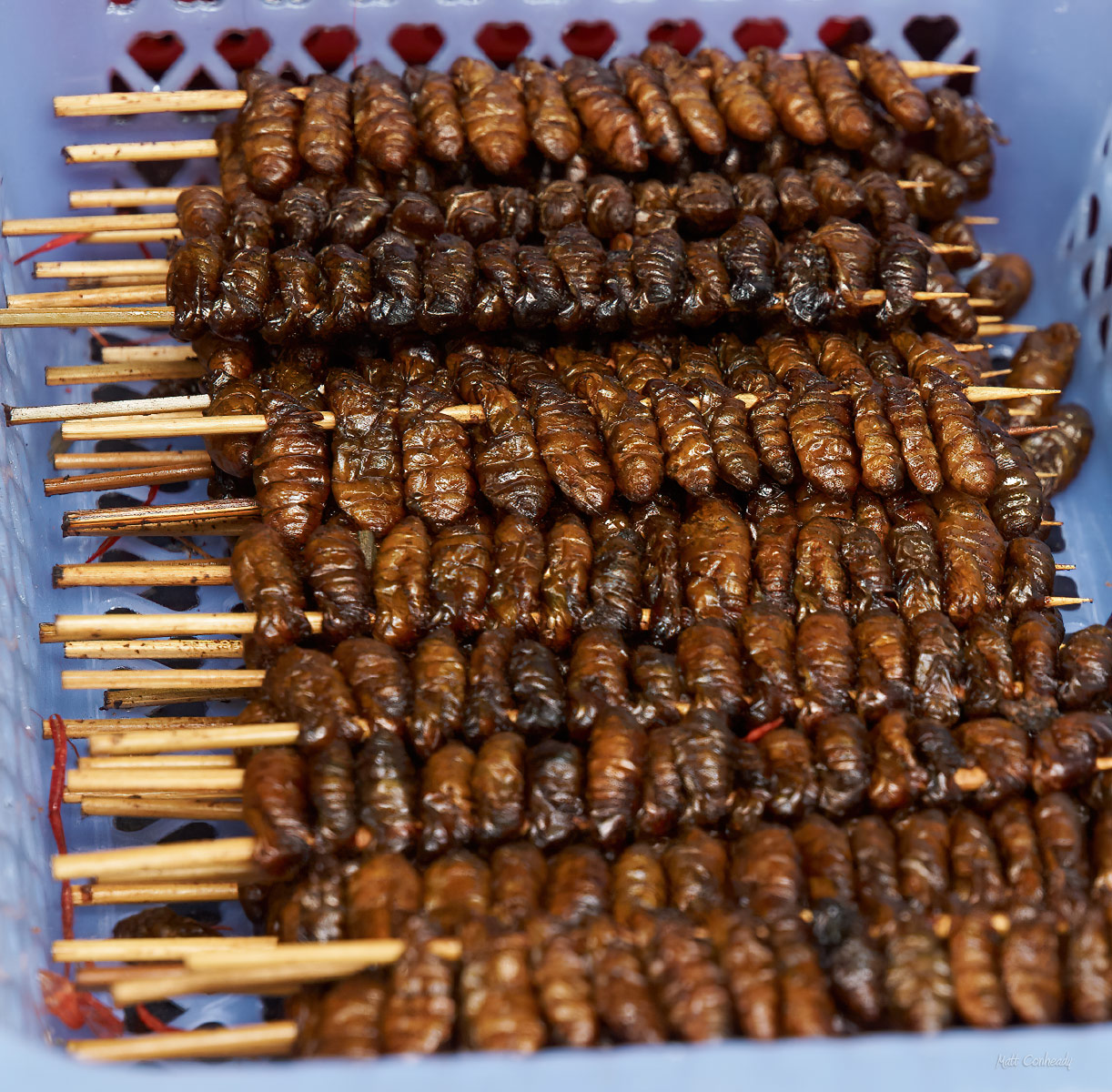
Sweet rice cakes. The drawings are actually the pictographic Dongba writing system of the naxi people.

Fried Tofu covered in chili powder

Fried bantam eggs on a stick
I order up two yak-on-a-sticks and one black-goat-on-a-stick

Of course, it’s all fried in the same oil used for the shrimp, bugs, and whatever else.

Yak, yak, goat (covered in Sichuan chilies)

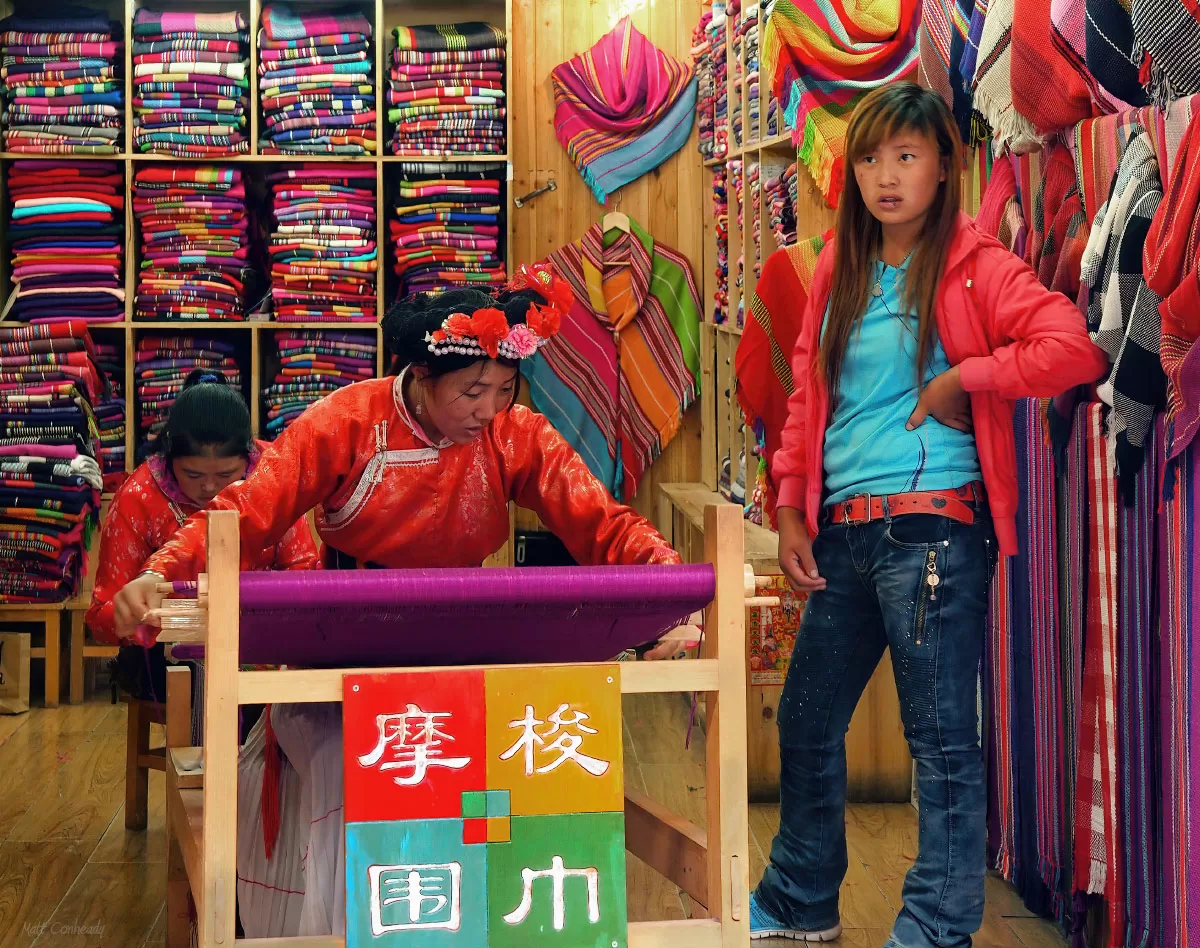
Watch your step. Nearly every alley has an adjacent canal. Not a railing to be found.

The street at the base of the Golden Hill is lined with bars and restaurants blasting music and personality.

People don’t just come to Lijiang to eat, drink and drum in the streets. Artists from all over China come just capture their impression of the architecture. The visiting artists I saw (pen illustrators mostly), seemed to have found a nice quiet alley or bridge, sat for the better part of they day and drew. Their work was astoundingly detailed.


With canals lining nearly every major alley, getting to some shops and restaurants means crossing these 100+ year-old bridges. Not many have railings, and barely anyone looks as they cross. It’s is a daily occurrence for people to fall in. Mostly tourists.



A big concern here is fire. These old building are irreplaceable. Fire buckets are stacked near the canal.



Plastic dolls adorn handmade traditional costumes from various Chinese ethnic minorities. If you ever wanted a Yi wedding gown for your barbie, this is the place.

Many shops sell fabric scarves which are usually woven right within the store.

In every corner of the old town, people just set up a little cooking station and sell snacks

Even the old-style Tibetan restaurants have free wifi.

This amazing wood-burning artist had a cornerstone shop with hundreds of beautiful Lijiang street scenes charred into lumber cross-sections. Who cares. Check out that stunning mullet!

I wanted to see what was on top of the Golden Mountain… so we began working our way through the maze of alleys to get there. There are hundreds of twists, turns, alleys and canals. I realize I can’t see all of this in one trip.

This shop sells bootleg CDs… that is when the owners aren’t jamming on their drums.

Hundreds of shops, thousands of shoppers.

Naxi horseman.

You can buy fruit flavored drinkable yak yogurt everywhere.

There’s quite a bit of international food available, such as this strawberry crepe. It uses some sort of strawberry syrup and not fresh strawberries.

Some shops tuck their doors in alleyways during the day. It’s amazing how many nooks there are to explore in the old town.

Making our way up the hill called Lion Rock, alleys get smaller, but remain confusing to navigate. This place is packed with businesses.

Some modern buildings built atop ancient foundations.

A central alley near the top serves up spectacular views of the Old Town from above. It is lined with doorways that are just walls with doors. Behind them are steps that lead to to the restaurants below.

A stitched panoramic of the Old Town with the sun getting low. I believe this is facing southeast.
 Click to enlarge
Click to enlarge
The view to the east (I think) Click to enlarge
Click to enlarge
Near the top.. there are entrance-ways to a park. It’s about $12 to get in.

Walking up, this puppy spots me and then proceeds to follow me. The streets of Lijiang are filled with wandering puppies.

I sit for a while and watch a B-Ball game taking place in a full court near the park at the top of the hill. Did I mention how much the Chinese people love basketball?

I had to pee… this is what a (clean) traditional public men’s room (with plumbing) looks like in China. Urinal trough on the left. Squat trough on the right. BYO paper.

…and he’s there waiting for me.


Losing light… have a ways to go.

Alleys are getting smaller and tighter.

I ditch Jing, who was too tired to make it the rest of the way. I run up steps to make it to the gateway that leads to the tower up top. I couple warns me to slow down-but there are plenty more steps to go and light is getting dim.

Walking around the outside of the tower, I was amazed at the details in the architecture.

A bonsai garden and gate. Bonsai, although typically thought of a Japanese gardening art, actually began in China.

Going to climb this next.

A bell. I guess if you are a white tourist, they don’t mind you ringing it a few times, but they sure do cast stares.

The grounds are surrounded by these trees. I can’t really call it a dense woods, because although there were a lot of them packed in, I could easily walk through.


A lot of small tables, and stone sculptures on the grounds.

Drum… not sure what it’s used for. Knowing the Chinese, you probably pay money and drum it for good luck.

The pagoda ceiling over the drum.


Panoramic view of the Ancient Town at Dusk (Click to enlarge)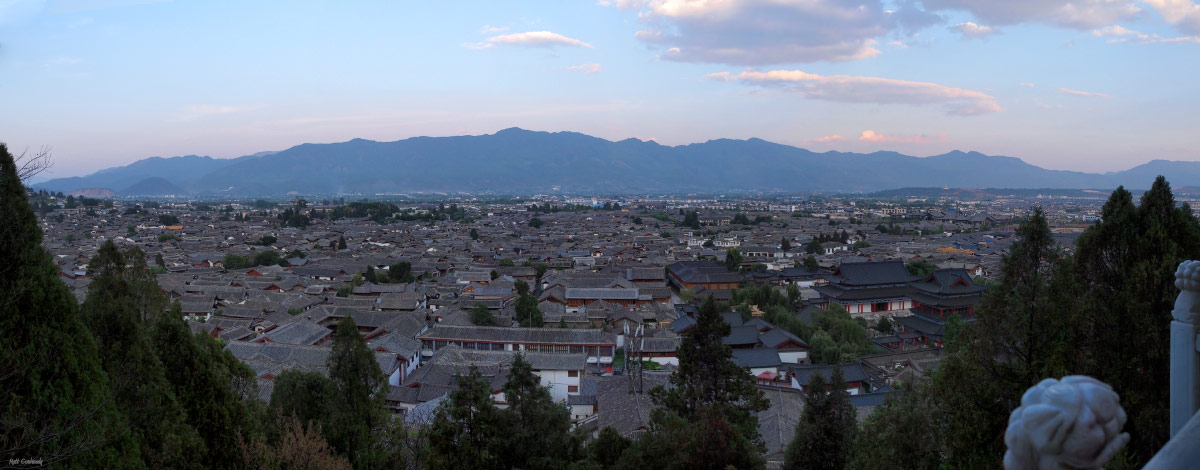
Tie a pine cone to the tree for good luck. Here is a message a girl wrote to her sweetheart.

They had traditional costumes for people to wear for photos. No thanks!

Sunset time! Entered the tower… and realized I should have come earlier– the interior was intricately hand carved and painted, really amazing, and it was set up as a 5-story art and book store. Awesome! But one problem… only natural light. Proceeded up the steps and waited for the right moment.

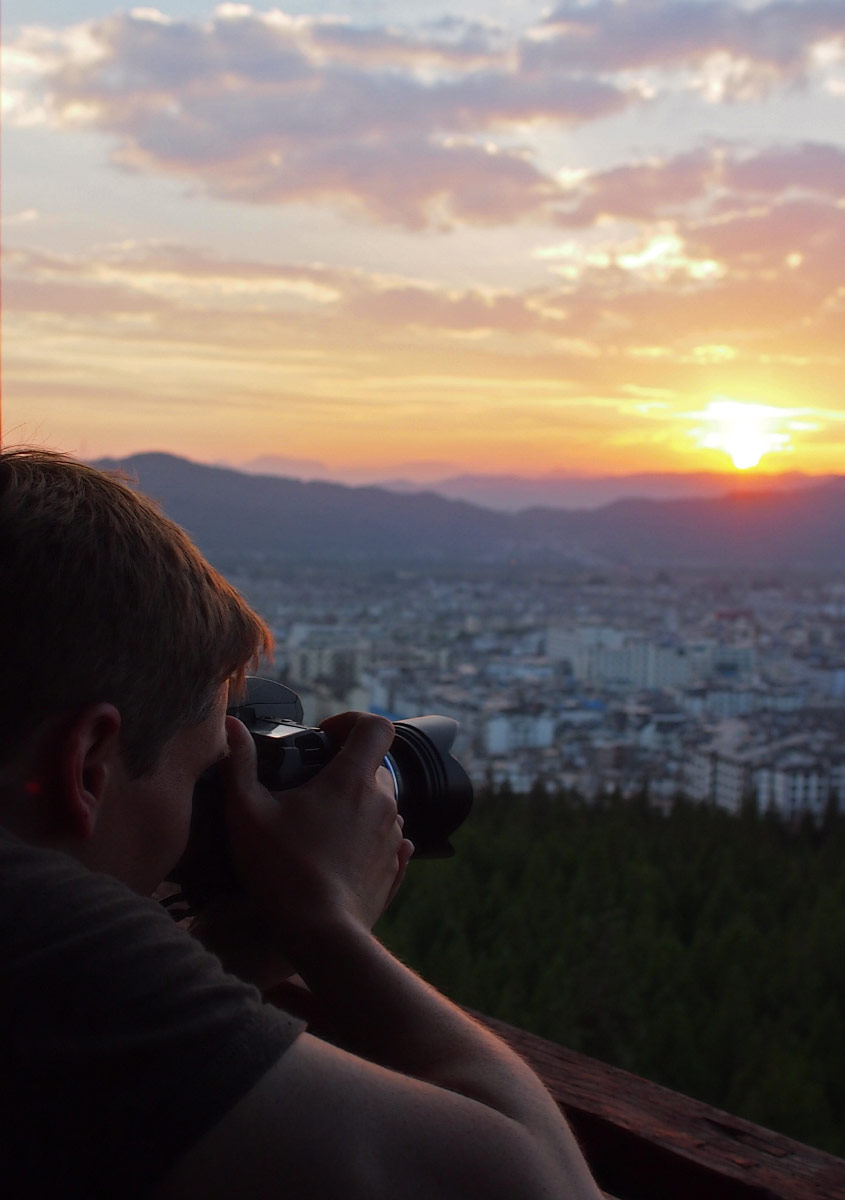
Jing caught up


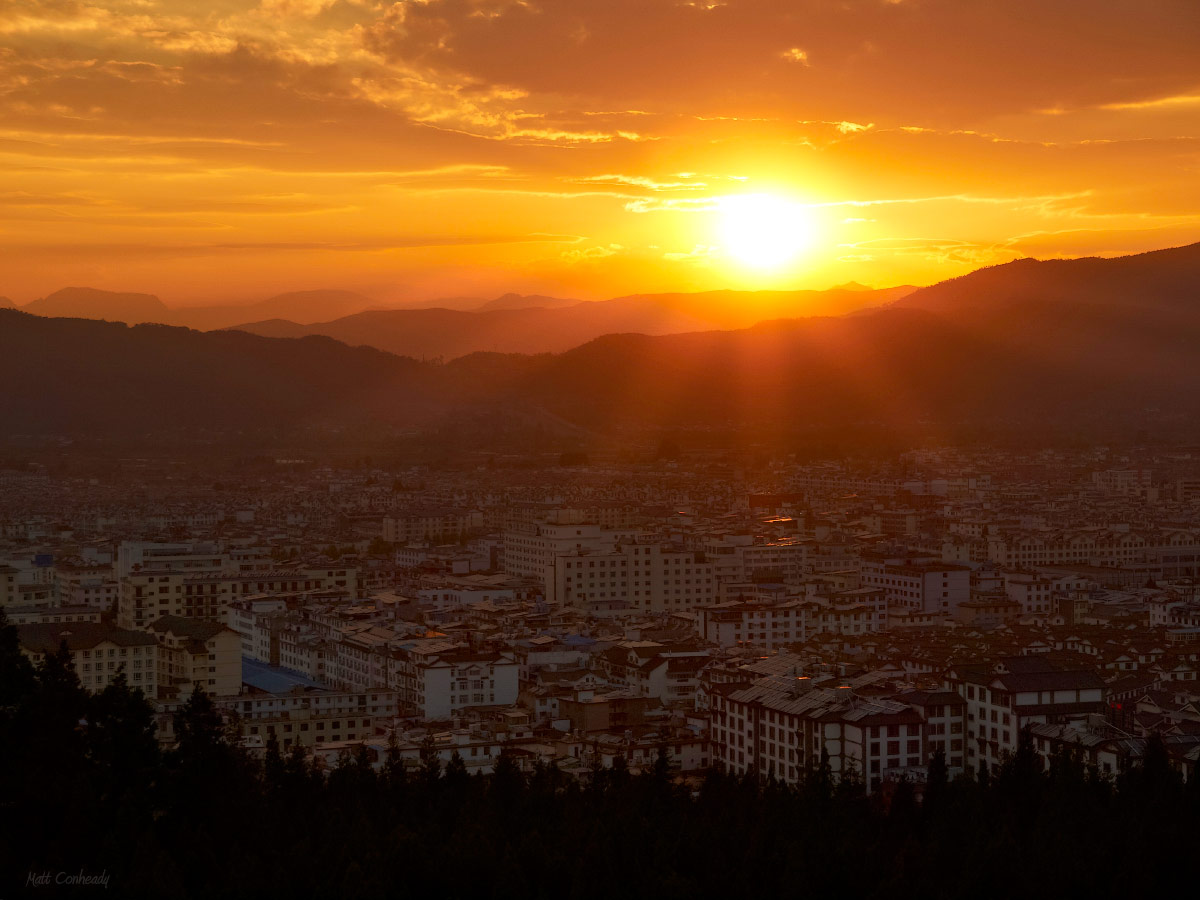
I learned in this town that it’s always worth taking the extra time to shoot a proper panoramic image. Click this one to see a larger version.

Hiding behind the clouds is the summit of Jade Dragon Snow Mountain. Tomorrow I am headed there. It doesn’t look to big from here… but it’s a 40 minute drive from the city. It’s the largest mountain in the region.

We headed down to do some shopping and grab a bite to eat…

We headed right to one of the food courts and I had one of my favorite dishes of this trip: clay pot casserole. It is a mix of pork, veggies, pickles, and potatoes over roasted rice.

The best shop I found sold handmade clay Dongba gods and other symbols. I bought a bunch as gifts.

This is a silver shop. There are quite a few of them. It seems as though a lot of the goods are shipped in, but during the day you can also see some of the shop workers hammering away at the metal. This worker is threading a necklace.

Lijiang at night is simply beautiful. All the right things are lit up and there are some beautiful scenes emerging from the darkness. It helps to have a camera with superb low-light capabilities, which i did not have at this time. But I did my best.

It’s easy to get lost in the alleys. Many go completely dark. I will admit, we got lost several times.

But there’s always some character to each alley… remember just a few shops you have to pass, and you can make it back to the hotel. I remember my hotel is a left at the Mountain Peak Inn.


Write a Reply or Comment